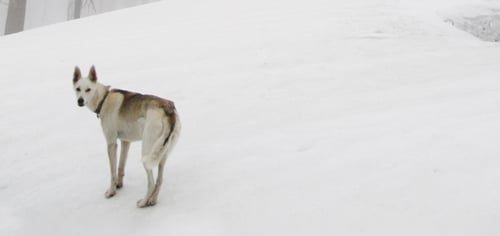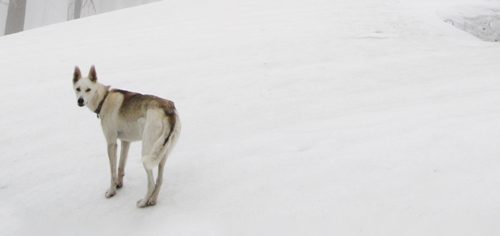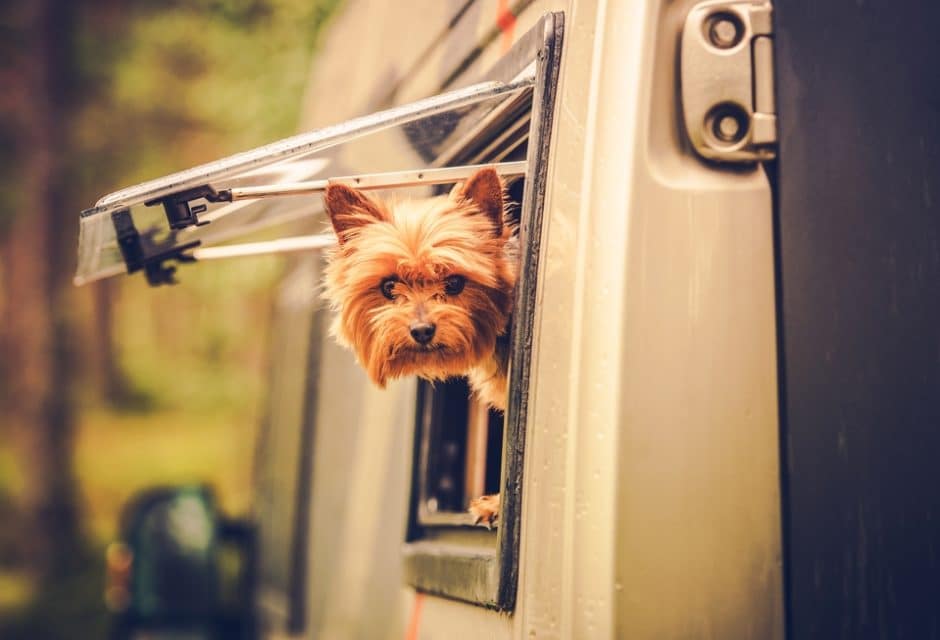

Lost
A writer and her dog venture deep into the backcountry
Alone…in the middle of the Stanislaus National Forest in California. Nothing moved around me. Other than a few birdcalls, there was silence. The sun shone down on me, each drop of sweat increasing my dehydration— I was out of water. My snowshoe trail could be seen coming down the ridge, then disappearing into patches of dirt. I paused, called out my dog’s name: Alma Rose. Silence. Silence for the last hour.
Last spring I decided to make happiness a priority in my life. Struggling with an unsatisfying job where I had no time or money to enjoy life, I decided to disappear into the woods with my dog.
Alma Rose is a sled dog from Grizzle-T, the dog sledding company I worked for in Colorado. I brought her home as a puppy and she has been my best friend ever since. She is a mutt, but predominately Husky and Greyhound, tall, lean and fast, thriving in the snow and climbing her first 14,000-foot mountain at six months old. I knew she would take well to the wild.
I had spent three seasons as a backcountry volunteer in my twenties in Yosemite National Park; the Sierras felt like home. I quit my job and headed to the forest bordering Yosemite with enough food and supplies for two months. The plan was to carry it in, cache it and resupply as needed. Complete isolation.
It was a tiring two-day drive in May to Cherry Creek, our entrance point to the wild, only to find the road still buried with snow. Although I didn’t expect so much snow, I was prepared. I put Alma’s Ruff Wear pack on her, filled with food. I strapped on my own pack to show her we were in this together. Within 50 feet, we reached our first downed log. Normally, Alma would have hopped right over it, but with her pack on, she dragged behind me until she saw a chipmunk; then she was off, running full speed. We hiked about two miles up the trail, a steep set of switchbacks putting us on top of a granite ridge, where I scouted for a place to camp.
That day we went up and down the trail four times bringing in supplies. Each time Alma became less enthusiastic until I pulled out her dog harness, strapped it to me and to the 30-gallon bear-proof bin to haul it up the trail and then I swear she laughed. I tried to tell her that this was a great adventure, but she wasn’t so sure.
The days that followed were filled with exploration, moving deeper and deeper into the backcountry. Each move took multiple trips: one to explore, find water, shade, and sun; one for the first load of food; and one for the load of supplies. Alma made one trip with her pack, and then she got to run free. Snow flurries came and went but we managed to find some open ground to camp on.
We hiked up ridges, down to lakes, feeling like we were in an undiscovered world. Two weeks in and a late season storm hit, dropping over a foot of snow the first day. I shoveled snow off the tent and Alma explored close by—she always stayed close by. The next day brought more snow and we had another tent day. Waking up on the third morning, Alma Rose was shivering on her bed. My tent was leaking and half my gear and her bed were soaked. I knew we had to hike out.
With a full pack, I struggled in the snow; Alma was happy to be moving. For twelve hours, we broke trail through three feet of fresh snow, Alma in front, up to her stomach in most places, unsure but steady. Finally I left our packs, knowing with the weight and the pace I was going we wouldn’t find our way out before dark and we could be in a bad situation. Loads lightened, we found the road, signaling another two and a half hours to the car. My steps plodded while Alma ran and chased and scented until we were safe, fourteen hours after leaving camp.
I bought a tent and a sleeping pad for Alma. We hiked back in, got our gear and disappeared. Our camp was in a bowl, on the only dry, flat rock available. We spent days walking along Cherry Creek, leaving a track of dog prints and snowshoe prints, climbing ridges and investigating lakes. About a month into our journey, my water purifier broke, so I had to boil water with my camp stove, but that wasted fuel I needed for cooking food and I knew I didn’t have much fuel left.
During a late evening walk, I felt in my heart it was time to hike out. Down low, the path was opening up and soon we’d have to share our paradise with other hikers. We said farewell to the expansive granite landscapes and the neon ribbons of water opening into lakes and rivers, and said good-bye to the snow.
On the way out, we started running into patches of dirt. Alma had learned to follow my snowshoe tracks, but here there was nothing to follow. She often darted off after this or that, and the morning had been trying with her running off for 15 minutes at a time and me backtracking to find her.
We were on a ridge when I stopped to take off my snowshoes. I looked up and she was gone. I had no idea which way. I called out to her, but nothing. I knew from past experience she wouldn’t go back but would try to find me. Shouldering my pack, I felt confident she would appear. I called out to her as I moved along the ridge, each step in the beating sun dehydrating me. Alma knew where the cache was, so I headed in that direction.
When I reached the cache, over an hour had passed. I took off my pack, emotions flooding over me: anger that she had run off, fear of her getting her pack caught on something and getting stuck, sorrow that my best friend was gone. The part of me that knew all she brought to my life, knew I had to go back to try to find her. I had been hiking for close to 10 hours with almost no water.
Across from me was an algae-filled pond. I boiled water, then waited. No Alma Rose. The silence was suffocating. She wasn’t coming.
I left my pack behind a log, chugged the water, stuffing my emergency locator beacon, my knife, and a granola bar into pockets. I had an emergency whistle and started hiking back. Two hours passed. Every 20 feet I stopped, called her name and blew the whistle. Two hours, ten minutes. Stop. Call. Blow. Two and a half hours, three hours. I was debating whether to give up and go back before dark or keep on. How far could I go? I was exhausted.
Then I heard a noise rushing through the brush, a flash of movement, a red pack and my dog. My dog! Her pack was twisted around her body, one pack pocket open and filled with water, her legs tangled through straps. I hugged her and burst into tears. She pulled away and started down the trail, with a “get this pack off me and lets get out of here” look. She sniffed my snowshoe prints, to show me she had tried to track me. We practically ran down the trail, where she got a ton of treats.
That night she ate a huge dinner, then curled up with me on the bed at my friend’s house, as she always had at home. The next day we brought down what was left of our cache. Alma ran free all day with no pack. Although she stayed close and checked in with me every few minutes, the sight of a cheeky squirrel would send her racing away once more. Despite her harrowing experience of being “lost in the wilderness,” she had learned she could find her way. She wasn’t lost any more; she had made the wilderness as much her home as I had always felt it was mine.
Join the newsletter and never miss out on dog content again!
"*" indicates required fields
By clicking the arrow, you agree to our web Terms of Use and Privacy & Cookie Policy. Easy unsubscribe links are provided in every email.





